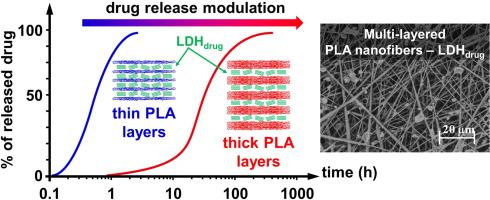当前位置:
X-MOL 学术
›
Eur. Polym. J.
›
论文详情
Our official English website, www.x-mol.net, welcomes your
feedback! (Note: you will need to create a separate account there.)
Design of 3D Multi-Layered Electrospun Membranes Embedding Iron-Based Layered Double Hydroxide for Drug Storage and Control of Sustained Release
European Polymer Journal ( IF 5.8 ) Pub Date : 2020-05-01 , DOI: 10.1016/j.eurpolymj.2020.109675 Mariana P. Figueiredo , Géraldine Layrac , Anne Hébraud , Lionel Limousy , Jocelyne Brendle , Guy Schlatter , Vera R.L. Constantino
European Polymer Journal ( IF 5.8 ) Pub Date : 2020-05-01 , DOI: 10.1016/j.eurpolymj.2020.109675 Mariana P. Figueiredo , Géraldine Layrac , Anne Hébraud , Lionel Limousy , Jocelyne Brendle , Guy Schlatter , Vera R.L. Constantino

|
Abstract Nowadays polymer dressings are expected to possess multiply functions. Besides acting as physical barriers, dressings may provide for the injured tissue species able to turn wound healing process faster and painless. In this way, dressings can be designed aiming to enable the release of drugs. The possibility to modulate drug release kinetics is a desired characteristic to be achieved in order to turn drug delivery systems adequate to specific treatments. However, hydrophilic drugs and hydrophobic polymers incompatibility hinders such modulation and a long-term release cannot be achieved efficiently. Here we present the design of poly(lactic acid) (PLA) membranes containing iron-based Layered Double Hydroxide (LDH) particles able to storage a hydrophilic anionic drug (derived from the non-steroidal anti-inflammatory naproxen). LDH particles are excellent candidates to compose multifunctional composites. They may present diverse biocompatible compositions, possess an elevated encapsulation capacity and tends to promote drugs sustained release by its own, besides assisting tissues regeneration process. Nanofibrous membranes were prepared by the combination of electrospun PLA and electrosprayed LDH as alternated layers (approach A) and also by both technics performed at the same time (approach B). In approach A, by varying the thickness of the PLA fibrous layers, it was possible to easily modulate the drug release rate. Half of drug content was released after 1, 4 and 17 days for the membranes containing the thinnest, the intermediate and the thicker PLA layers, respectively, and after 56 h for the membrane prepared by the approach B. Naproxen release was kept for 18 days for the thinnest membrane, 59 days for the membrane prepared by the approach B and 66 days for the thicker membranes. We believe that this work can inspire the development of new functional membranes with tunable drug release profile thanks to the versatile electrospinning and electrospraying techniques.
中文翻译:

用于药物储存和缓释控制的嵌入铁基层状双氢氧化物的 3D 多层电纺膜的设计
摘要 如今,聚合物敷料被期望具有多种功能。除了作为物理屏障外,敷料还可以为受伤的组织提供更快、更无痛的伤口愈合过程。通过这种方式,可以设计敷料以实现药物的释放。调节药物释放动力学的可能性是需要实现的特性,以便使药物递送系统适合特定治疗。然而,亲水性药物和疏水性聚合物的不相容性阻碍了这种调节,并且不能有效地实现长期释放。在这里,我们介绍了含有铁基层状双氢氧化物 (LDH) 颗粒的聚乳酸 (PLA) 膜的设计,能够储存亲水性阴离子药物(来自非甾体抗炎萘普生)。LDH 颗粒是组成多功能复合材料的极好候选者。它们可能呈现不同的生物相容性组合物,具有较高的包封能力,除了有助于组织再生过程外,还倾向于通过自身促进药物的持续释放。纳米纤维膜是通过将电纺 PLA 和电喷涂 LDH 组合作为交替层(方法 A)以及同时进行的两种技术(方法 B)来制备的。在方法 A 中,通过改变 PLA 纤维层的厚度,可以轻松调节药物释放速率。对于含有最薄、中间和较厚 PLA 层的膜,分别在 1、4 和 17 天后释放一半的药物含量,对于方法 B 制备的膜在 56 小时后释放。最薄的膜的萘普生释放保持 18 天,方法 B 制备的膜保持 59 天,较厚的膜保持 66 天。我们相信,由于多功能的静电纺丝和电喷雾技术,这项工作可以激发具有可调药物释放曲线的新功能膜的开发。
更新日期:2020-05-01
中文翻译:

用于药物储存和缓释控制的嵌入铁基层状双氢氧化物的 3D 多层电纺膜的设计
摘要 如今,聚合物敷料被期望具有多种功能。除了作为物理屏障外,敷料还可以为受伤的组织提供更快、更无痛的伤口愈合过程。通过这种方式,可以设计敷料以实现药物的释放。调节药物释放动力学的可能性是需要实现的特性,以便使药物递送系统适合特定治疗。然而,亲水性药物和疏水性聚合物的不相容性阻碍了这种调节,并且不能有效地实现长期释放。在这里,我们介绍了含有铁基层状双氢氧化物 (LDH) 颗粒的聚乳酸 (PLA) 膜的设计,能够储存亲水性阴离子药物(来自非甾体抗炎萘普生)。LDH 颗粒是组成多功能复合材料的极好候选者。它们可能呈现不同的生物相容性组合物,具有较高的包封能力,除了有助于组织再生过程外,还倾向于通过自身促进药物的持续释放。纳米纤维膜是通过将电纺 PLA 和电喷涂 LDH 组合作为交替层(方法 A)以及同时进行的两种技术(方法 B)来制备的。在方法 A 中,通过改变 PLA 纤维层的厚度,可以轻松调节药物释放速率。对于含有最薄、中间和较厚 PLA 层的膜,分别在 1、4 和 17 天后释放一半的药物含量,对于方法 B 制备的膜在 56 小时后释放。最薄的膜的萘普生释放保持 18 天,方法 B 制备的膜保持 59 天,较厚的膜保持 66 天。我们相信,由于多功能的静电纺丝和电喷雾技术,这项工作可以激发具有可调药物释放曲线的新功能膜的开发。











































 京公网安备 11010802027423号
京公网安备 11010802027423号